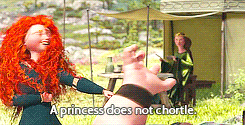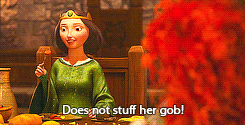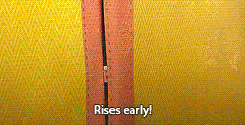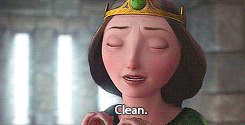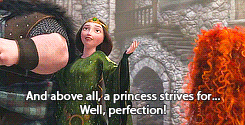Quote
This is an excellent writing advice from Chuck Palahniuk. This was first seen on tumblr. Unfortunately, when I clicked on the link, it no longer existed.
But, I still think it’s worth sharing.
writingadvice: by Chuck Palahniuk
In six seconds, you’ll hate me.
But in six months, you’ll be a better writer.
From this point forward—at least for the next half year—you may not
use “thought” verbs. These include: Thinks, Knows, Understands,
Realizes, Believes, Wants, Remembers, Imagines, Desires, and a hundred
others you love to use.
The list should also include: Loves and Hates.
And it should include: Is and Has, but we’ll get to those later.
Until some time around Christmas, you can’t write: Kenny wondered if Monica didn’t like him going out at night…”
Instead, you’ll have to Un-pack that to something like: “The
mornings after Kenny had stayed out, beyond the last bus, until he’d
had to bum a ride or pay for a cab and got home to find Monica faking
sleep, faking because she never slept that quiet, those mornings, she’d
only put her own cup of coffee in the microwave. Never his.”
Instead of characters knowing anything, you must now present
the details that allow the reader to know them. Instead of a character
wanting something, you must now describe the thing so that the reader
wants it.
Instead of saying: “Adam knew Gwen liked him.” You’ll have
to say: “Between classes, Gwen had always leaned on his locker when he’d
go to open it. She’s roll her eyes and shove off with one foot,
leaving a black-heel mark on the painted metal, but she also left the
smell of her perfume. The combination lock would still be warm from her
butt. And the next break, Gwen would be leaned there, again.”
In short, no more short-cuts. Only specific sensory detail: action, smell, taste, sound, and feeling.
Typically,
writers use these “thought” verbs at the beginning of a paragraph (In
this form, you can call them “Thesis Statements” and I’ll rail against
those, later). In a way, they state the intention of the paragraph. And
what follows, illustrates them.
For example:
“Brenda knew she’d never make the deadline. Traffic
was backed up from the bridge, past the first eight or nine exits. Her
cell phone battery was dead. At home, the dogs would need to go out, or
there would be a mess to clean up. Plus, she’d promised to water the
plants for her neighbor…”
Do you see how the opening “thesis statement” steals the thunder of what follows? Don’t do it.
If nothing else, cut the opening sentence and place it after all the others. Better yet, transplant it and change it to: Brenda would never make the deadline.
Thinking is abstract. Knowing and believing are intangible. Your
story will always be stronger if you just show the physical actions
and details of your characters and allow your reader to do the thinking
and knowing. And loving and hating.
Don’t tell your reader: “Lisa hated Tom.”
Instead, make your case like a lawyer in court, detail by detail.
Present each piece of evidence. For example:
“During roll call,
in the breath after the teacher said Tom’s name, in that moment before
he could answer, right then, Lisa would whisper-shout ‘Butt Wipe,’ just
as Tom was saying, ‘Here’.”
One of the most-common mistakes that beginning writers make is leaving their characters alone. Writing,
you may be alone. Reading, your audience may be alone. But your
character should spend very, very little time alone. Because a solitary
character starts thinking or worrying or wondering.
For example: Waiting for the bus, Mark started to worry about how long the trip would take…”
A better break-down might be: “The schedule said the bus would come
by at noon, but Mark’s watch said it was already 11:57. You could see
all the way down the road, as far as the Mall, and not see a bus. No
doubt, the driver was parked at the turn-around, the far end of the
line, taking a nap. The driver was kicked back, asleep, and Mark was
going to be late. Or worse, the driver was drinking, and he’d pull up
drunk and charge Mark seventy-five cents for death in a fiery traffic
accident…”
A character alone must lapse into fantasy or memory, but even then
you can’t use “thought” verbs or any of their abstract relatives.
Oh, and you can just forget about using the verbs forget and remember.
No more transitions such as: “Wanda remembered how Nelson used to brush her hair.”
Instead: “Back in their sophomore year, Nelson used to brush her hair with smooth, long strokes of his hand.”
Again, Un-pack. Don’t take short-cuts.
Better yet, get your character with another character, fast.
Get them together and get the action started. Let their actions and
words show their thoughts. You—stay out of their heads.
And while you’re avoiding “thought” verbs, be very wary about using the bland verbs “is” and “have.”
For example:
“Ann’s eyes are blue.”
“Ann has blue eyes.”
Versus:
“Ann coughed and waved one hand past her face, clearing the cigarette smoke from her eyes, blue eyes, before she smiled…”
Instead of bland “is” and “has” statements, try burying your details
of what a character has or is, in actions or gestures. At its most
basic, this is showing your story instead of telling it.
And forever after, once you’ve learned to Un-pack your characters,
you’ll hate the lazy writer who settles for: “Jim sat beside the
telephone, wondering why Amanda didn’t call.”
Please. For now, hate me all you want, but don’t use thought verbs. After Christmas, go crazy, but I’d bet money you won’t.
(…)
For this month’s homework, pick through your writing and circle every “thought” verb. Then, find some way to eliminate it. Kill it by Un-packing it.
Then, pick through some published fiction and do the same thing. Be ruthless.
“Marty imagined fish, jumping in the moonlight…”
“Nancy recalled the way the wine tasted…”
“Larry knew he was a dead man…”
Find them. After that, find a way to re-write them. Make them stronger.
Thanks Hiraku! (via wingedbeastie)
178K notes
·
View notes
Text
Our (Non-Comprehensive) List of Fairytales
Here’s our list of fairy tales, fables, ghost stories, myths, legends, and sacred tales, classified according to land of origin. Many of the stories are available online; others can be found in folktale collections in libraries. Feel free to use these, or any of your own choice outside of this list.
MALAYSIA/SINGAPORE/INDONESIA
Sang Nila Utama and the founding of Singapore
Badang, the strongman
Lancang Kuning
Siti Zubaidah
Singapura Dilanggar Todak (The Legend of the Swordfish and Bukit Merah)
Puteri Gunung Ledang
Bawang Merah, Bawang Putih
Sangkuriang
Prince Panji
Keong Emas, the Golden Snail
Legend of the Pontianak
Legend of the Penanggalan
Sang Kancil, the Clever Mousedeer
Hang Tuah
Dang Anom
Pak Pandir, the Village Fool
Mahsuri, the Maiden of Langkawi
The Dragon of Mt Kinabalu
Dewi Sri, the Rice Goddess
Bangsat and the King of the Crocodiles
Rangda and the Barong
The Tale of Sisters’ Islands
The Tale of Kusu Island
CHINA
Pan Gu creates the world
Nü Wa creates humans and repairs the sky
Hou Yi shoots the sun, Chang’er flies to the moon
Nian and the Story of Chinese New Year
The Canonisation of the Gods
The Legend of Ne Zha
The Cowherd and the Weaver Girl
Hua Mulan
Lady Mengjiang and the Great Wall
The Eight Immortals Cross the Sea
Journey to the West (aka Monkey King)
Liang Zhu: The Butterfly Lovers
Lady White Snake
The Magic Paintbrush
The Fox Fairy (and anything from Strange Tales of Liaozhai)
The 24 Paragons of Filial Piety
The Dragon King’s Daughter
Mulian Rescues his Mother From Hell
Tales from Justice Bao (e.g. the Civet for a Crown Prince)
Ma Zu, the Sea Goddess
Tales of Ji Gong
INDIA
Tales from the Ramayana
Tales from the Mahabharata
Tales from the Life of the Buddha
Tales from the Panchatantra
Sukhu and Dukhu
Tenali Raman the Jester
Tales of Akbar and Birbal
The Mongoose and the Jackal
Tales of Suppandi
WEST ASIA
Scheherazade
Aladdin
Ali Baba and the Forty Thieves
Sinbad the Sailor
The Fisherman and the Jinni
Tales of the Mullah Nasruddin
The Tale of the Hunchback
Rostam
The Seven Wise Princesses
JAPAN
Izanami and Izanagi
Amaterasu and Uzume
Issun-Boshi, the One-Inch Boy
Momotaro the Peach Boy
Tokoyo
Urashima Taro and the Turtle
Kiyohime
Hanasaka Jiisan, the Old Man Who Made the Cherry Blossoms Bloom
The Tale of the Bamboo Cutter (aka The Moon Princess)
The Rabbit in the Moon
O-Jizo San, the Grateful Statues
The Magic Tea-Kettle
The Tale of the Gallant Jiraiya
KOREA
The Story Bag
The Mirror and the Villagers (aka The Bridegroom’s Shopping)
Janghwa and Hongryeon
Heungbu and Nolbu
Chunhyangga
The Disowned Student and the Field Rat Spirit
The Three Princesses and the Land-Below-the-Earth
PHILIPPINES
Alitaptap, the Princess who became Fireflies
Ibong Adarna
Bernardo Carpio
Juan Tamad
Lam-Ang
Maria Makiling
The Creation of the Pineapple
The Creation of the Banana Tree
The Creation of the Durian
The Creation of the Rose
THAILAND
Nang Nak Phrakhanong
Manohra, the Kinnari (Bird Maiden)
VIETNAM
Tam and Cam
The Hundred-Knot Bamboo Tree
10K notes
·
View notes
Note
Hi, how come some links eg the graphics tutorials and FC Help don't work? x
I have no idea, no matter what I try, it won't link. But what can I help you with? :)
0 notes
Note
hey so i need advice in something: i don't know if i should go through with a book idea... i want to do a reincarnation thing, with the first half of the book in todays normal world and then the second half (the secong book if you will) in a supernatural world kind of thing. i want to use the same characters, like they die in the first half and the second book cuts to a time where they are in the other world... should i do it like that? cut it to two halves? thanks in advance :)
I think so. It means you can incorporate parts of the future story into the current one to create a better flow, I think it's a fantastic idea!
0 notes
Photo
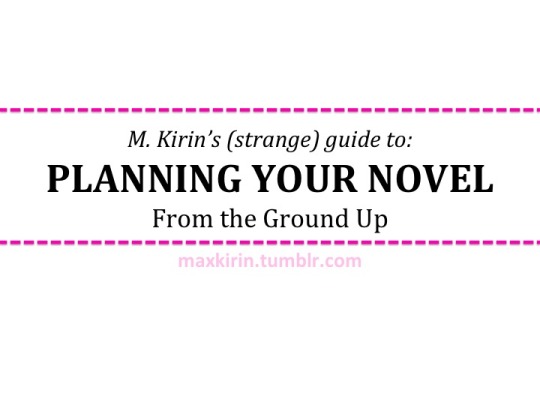

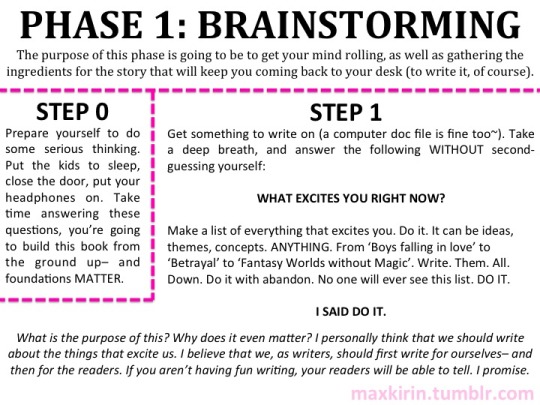

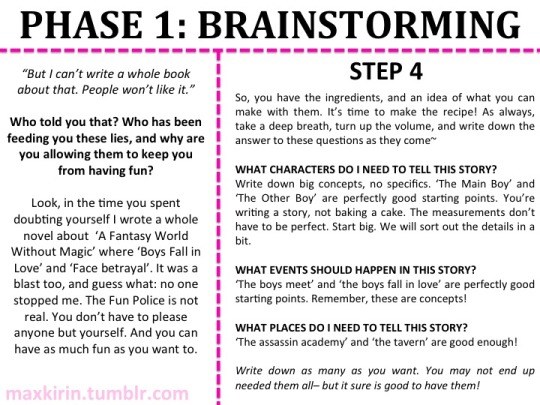
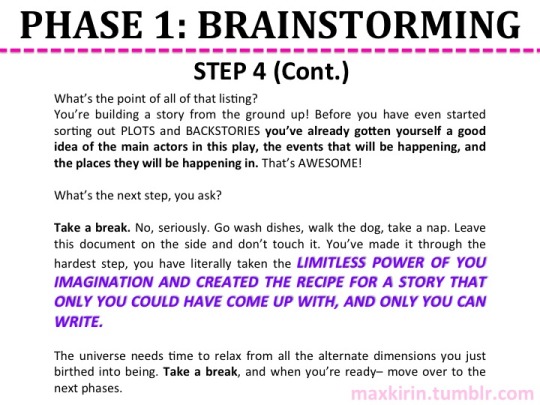

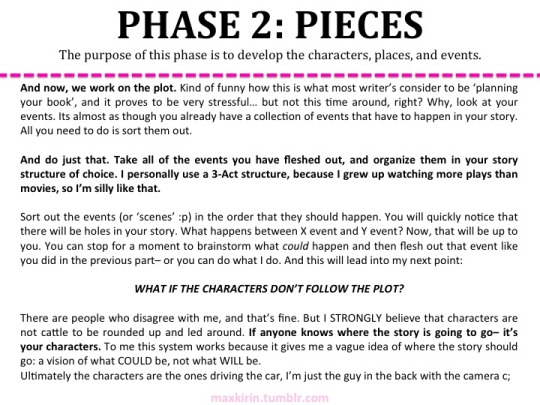
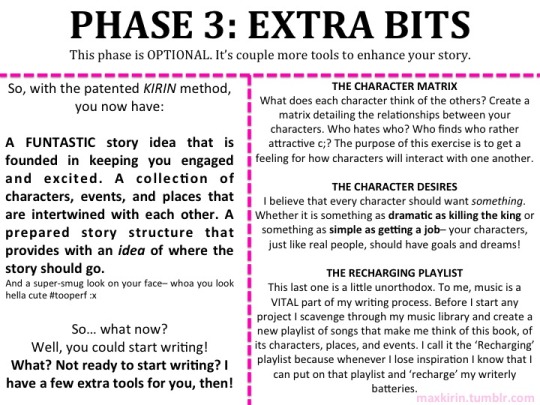

So, someone wanted some tips on planning/outlining their novel and instead I made this. It kind of happened.
If you’re new to my silliness let me introduce myself.
My name is M. Kirin and I write books. If you’re interested in writer resources, inspiration, and the adventures of a dork, you could do a lot worse than me :3
34K notes
·
View notes
Text
A Body Language Masterlist
Cheat Sheets
Body Language Cheat Sheet (archetypewriting)
Body Language Cheat Sheet (writerswrite1)
Writing-Specific Guides
Using Body Language to Create Believable Characters
Character Emotion Written All Over Their Face
Ideas For Using Knowledge of Body Language in Your Writing
Elaboration: The Power Punch of “Body Language” Detail
How to Read a Person Like a Book
Body Language: An Artistic Writing Tool
Body Language Basics
41 Flavors of Body Language for Writers (very nice guide/reference)
Reveal Character Through Body Language (a good quick reference with emotions and behaviors associated with them)
Non-Writing Specific Guides
Dimensions of Body Language (very extensive with pictures)
Nonverbal Dictionary
Body Language Index (lots of tables, resources, and terms. I highly recommend checking out this link)
Body Language Wikipedia Page
Important Features of Body Language
Exercises
Creative Writing Exercises: Body Language
An Exercise in Character Differentiation
A Conversation Through Body Language
9K notes
·
View notes
Photo
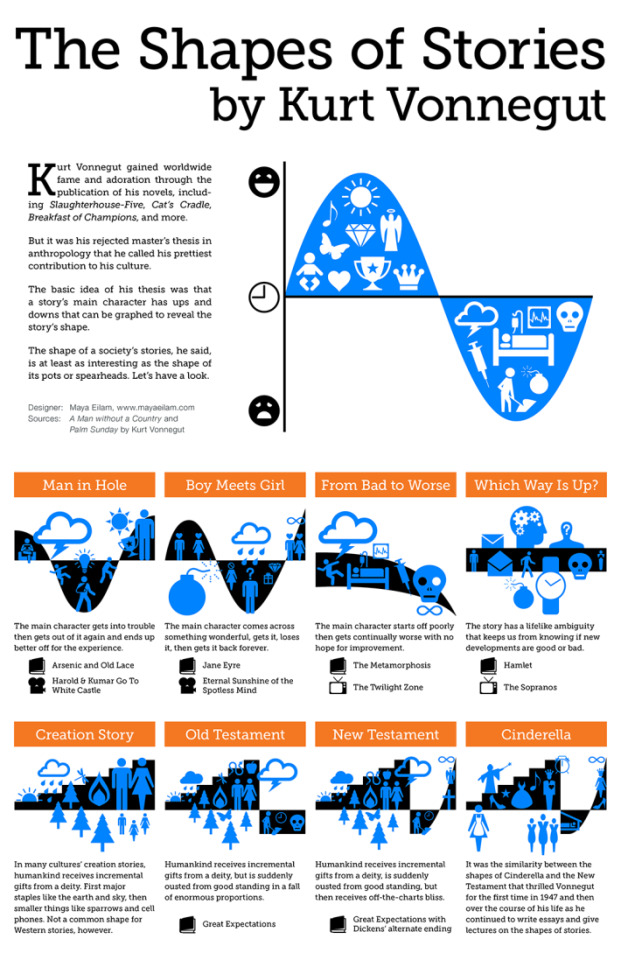
The Shapes of Stories, a Kurt Vonnegut Infographic on Narrative Structure
1K notes
·
View notes
Text
Three Goals for Every Character
You can break down each character’s goals into three types: professional, private and personal.
‘Professional’ refers to the job that needs to be done. A monster has to be killed, a treasure has to be found, a wedding has to take place etc. This physical goal drives the main story and gives the hero something to do.
‘Private’ is something that characters want for themselves. It may not be the main focus of the story as it doesn’t necessarily affect other characters, but a character that only acts out of pure altruism and self-sacrifice is both unrealistic and a little annoying.
‘Personal’ is more about the psychological needs of the character. Whatever flaws or hang-ups the character might have (and he should definitely have some), there will have to be a resolution or understanding reached at some point in the story. This aspect is often the most rewarding and satisfying in a novel, but also risks being the most clichéd and obvious.
These three elements are often very closely linked and intertwined, but they can also be very separate. Both approaches have their advantages and their disadvantages.
Read More
3K notes
·
View notes
Photo








download fonts by wonderesources
Dolce Vita
Magnolia
Shipped Goods
Basic Title
Tommy Hilfiger
Fely
Enchanted Prairie Dog
Veron
639 notes
·
View notes
Photo

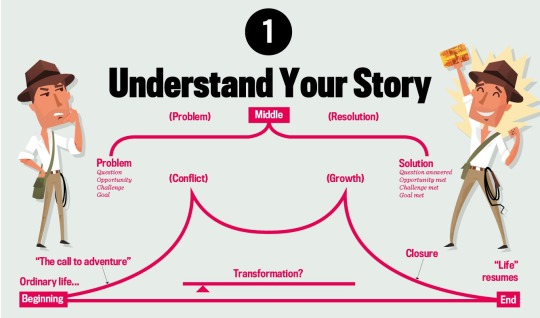





Seven Steps to the Perfect Story
From structure and plot to heroes and characters, your story must have everything in place if it’s to connect with the reader. Follow our guide to storytelling success.
122K notes
·
View notes
Text
1DFF easy chapter formatting tutorial
hello, earthlings. so i can only assume every author on 1DFF knows the struggle of posting a new chapter you’re super excited about only to see the site double space each passage and eat the ending. of course, you can turn off tinyMCE, c/p your chapter into the html box and manually go in and type in the line breaks to ensure the ending stays attached but that takes forever and sometimes, you don’t know all of the codes you need to know.
i’m here to tell you: i’ve figured out an easier way! through trial and error, i’ve learnt how to cheat the system and i hope this tutorial helps you out - if anything, to just save time and prevent you from accidentally deleting your story like i have.
all you need is google docs (or w/e program you use), textedit (i believe notepad works too but i’m a mac user) and tumblr.
Read More
30 notes
·
View notes
Photo

Some links I have found in various Tumblr Posts that I have saved on my computer. I do not take credit for collecting all these links. Unfortunately, I did not have the mind to save/note where these various links come from. Thank you to whoever compiled these links together.
General Writing Tips, Guides and Advice
How to be Confident in Your Writing
Start Your Novel Already!
Why First Chapters Matter
How to Outline a Novel
Incorporating Flashbacks
Word Building 101
Common Mistakes in Writing
Tips on Getting Started
What Not to Do
7 Tips to Become a Better Writer from Stephen King
How to Use Reading to Become a Better Writer
Why Writers Must Read
How to Finish What You Start: A Five-Step Plan for Writers
31 Ways to Find Inspiration for Your Writing
10 Tips to Write Fanfiction
Writing a Blurb
10 Writing Tips
Perfecting Description
Point of View
Speed Up Your Writing
Recieving Bad News
Useful Writing Apps
Avoiding Clichés
Writing Lessons
Finding Inspiration
Plot and Conflict
What is Conflict?
Where’s Your Conflict?
Adding Conflict to Your Scenes
Guides for Using Inner Conflict That Makes Sense
Plotting Your Novel
Internal and External Conflict
The Top Ten Plotting Problems
The Elements of Plot Development
Plot Help
Writing a Plot Your Own Way
Plot Development
Develop a Plot
Tension and Conflict
Your Plot, Step by Step
Plot vs. Exposition
Plot and Conflict
Character Development
How to Describe the Body Shape of Female Characters
Character Apperance Help
Words to Describe Voice
Body Language Cheat Sheet
Character Development Exercises
101 Character Development Questions
Art of Character Development
Introducing Characters
Characters You Need to Reinvent
Making Characters Likeable
Heros and Villains
Describing Clothing
Understanding Body Language
100 Positive Traits
Mental Illness in Writing
Conflicts and Characters
Indifferent, Distant Characters
Bitchy Characters
Describing Voice
Being a Bitch
Heartless Bitch
Writing Nice Characters
Character Questionnaire
Mental Disorders
Writing Characters with Mental Illness
Writing Male Characters
Playing Male Characters
Breaking Sterotypes
Characters with Glasses
Rebellious Characters
Writing Female Characters
Writing Intriuging Male and Female Characters
Spelling, Punctuation and Grammar
Placement of Speech Tags
Grammar and Spelling
Grammar Slammer!
American vs. British Grammar
HyperGrammar
Grammar Girl
Punctuating Dialogue
How to Use the Semicolon
Introduction to the Basic Rules of Punctuation
Comma 101
All About Dialouge
11 Grammar Tips
Comma Usage
Correct Use of Apostrophe
Proofreading
Transition Words
40+ Tips to Improve your Grammar and Punctuation
Better Writing: Grammar & Spelling
Semicolons and Colons
Underlining and Italicizing
Dashes and Parentheses
Hyphens
Apostrophes
The Ellipsis
List of 1000+ Adjectives
All About Names
List of Names
100 Most Popular Names
Sci-Fi Names
Sci-Fi Names Part 2
Name Berry
Behind the Name
Fantasy Name Generator
20,000+ Names From Around the World
Victorian Era Names
How to Choose a Name
Naming Your Characters
Give Your Character the Perfect Name
Name that Character!
10 Tips to Name Your Character
Genre Based
20 Tips to Writing Love Scenes
On Love And Sex
All That Sex!
Writing “Real” Men in Romance Fiction
Kissing
How to Write a Kissing Scene: Valentine Edition
How to Write a Kiss? And Should You Write Sex?
The Keys to Conflict
Writing Gender-Specific Dialouge
Things Smut Writers Should Know
How to Write a Sex Scene
3 Secrets to Writing Sex
Writing Love Scenes
Why You Should Write Love Stories
How to Write Horror
Horror Sub-Genres
Horror Plot Cliches
25 Things You Should Know About Writing Horror
Plot and Character in Horror Fiction
7 Laws of Comedy
5 Secrets for Improving Comedy Writing
How to Break into Comedy
How to Be Funny
Mystery Writing Lessons
10 Rules for Mystery
Mystery Writing
Other
Word Count
Story Starters & idea Generators
Fifty Quick Writing Prompts
Write or Die
Writing Prompt Generator
Dictionary.com
Thesaurus.com
Oxford Dictionary
Spanish Dictionary
Medical Dictionary
Your Dictionary
A Bunch of Character Questionnaires
85K notes
·
View notes
Note
Do you know of any good website to find screencaps?
Linking you to their tumblrs, which they usually use for updates.
Screencapped.net
Grandecaps
Blu-screens
HD-screencaps
Disneyscreencaps
Nickelodeoncaps
Lifeis-caps
Homeofthenutty
Hope this helped!
76 notes
·
View notes
Photo

Writing fantasy can be a bit overwhelming, especially since you have to create an entire world (in most sub genres) when you’re already trying to create characters and plots. Here’s a guide and some questions to get you started to inspire.
World Building:
Physical:
Geography: Make a map of your world. Start with an outline of the country, kingdom, or nation you’re making. Is it an island? Is it landlocked? Does it share borders with other countries or regions? Once you have your basic shape, you can add more borders within for states, provinces, kingdoms, and more smaller regions. Now place it somewhere on a globe. This will affect the geography and the climate of your world. Look up the ecosystems and geography of lands similar to yours.
Local Setting: Where is the general area that your story takes place? What does it look like? What does it feel like? Is there not enough sun because of all the trees? Are there mountains? Is there a tide? What does it smell like? Is the air polluted in one area more than another? How does that affect breathing, smell, and daily life? Those who lived near the Chicago Stockyards when it was open breathed bad air their entire lives. Going to a place with cleaner air was quite an odd experience for them.
Ecosystem: What animals are most common? Have your characters hunted any species to the point of extinction? Which animals have been domesticated? What plants and herbs grow there? Rural characters should have knowledge of the nature around them and the uses of certain plants and animals.
Climate: Climate depends on the geographical location and other environmental factors. This will affect your characters’ lives significantly.
Regions: Does your story take place in one country? Or many? Either way, these places are going to have small regions within whether they are called states, provinces, kingdoms, or whatever you want. Or maybe there are no regions. Your characters may just ambiguously refer to places as “the east” or “the lakes” if there is a place heavily ridden with bodies of water. A fictional island in one my stories has a place that many refer to as “the southern branch” because it is the southern most part of the island and it juts out from the rest. If you have regions, make up their borders. Are there border laws? Are people allowed to pass freely? Are criminals allowed to pass freely? Are there no set borders, but a general idea of where one region starts and another ends? Are there physical borders (such as a wall or a fence)? Do customs vary from region to region?
Astronomy: Consider how many moons your world has and constellations. Does your world notice stars? Have they given names to stars and constellations?
Villages, Towns, and Cities: When creating a city, town, or village, draw a map and consider who lives there. Draw the geography first. Is there a river that runs through it? Are there hills and forests? Or a swamp? Draw the major roads and note where there may be bridges or tunnels. Add the minor roads next and draw in buildings and homes. Your town could even follow a certain shape, like a circle that has a major building in the center. Maybe, for a smaller village, there is only one road and homes spread out on either side. Or perhaps there are no roads at all.
Population: How many people live in certain areas? Is the population high or low? Consider the average family size and life expectancy. If your characters live for a long time and have a low infant mortality rate, they may have a high population. Or maybe they live long enough to realize high population can be a problem, and thus limit the amount of children they have. The population will affect available jobs, amount of towns and cities, and the environment. Think of the diversity in the population. Are there more men than women? More children than adults? What about the percentages of race?
Foreign Lands: What are the foreign lands? Are they as advanced as the place your story takes place? More advanced? Less advanced? Do they have a bad or good history with your land? What is the relationship between these lands? How do their cultures differ? Are the borders controlled? What do these places look like? Have borders ever changed? Do mountains or rivers make up the borders?
Read More
10K notes
·
View notes




